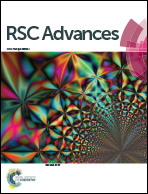Identification of the over alkylation sites of a protein by IAM in MALDI-TOF/TOF tandem mass spectrometry†
Abstract
Rationale: overalkylation often appears during the proteolytic digestion process when using iodoacetamide (IAM) to protect the produced side chain thiol of Cys from disulfide bonds. However, side reactions between IAM and other functional groups of amino acids have not been investigated completely. Here, matrix-assisted laser desorption ionization equipped with time of fight analyzer tandem mass spectrometry (MALDI-TOF/TOF MS) has been used to identify overalkylation sites and compare the reactivity of different amino acid residues accurately and rapidly. Methods: in this work, H13A protein, an angiogenin mutant with a mutation from His to Ala at the thirteenth site was analyzed by the bottom-up method and the overalkylation sites were determined by MALDI tandem mass spectrometry. Results: MS results show two or more acetyl groups can be attached to the tryptic peptides. MS/MS results further show the attached acetyl is produced by a reaction between IAM and the side chain of Asp, Lys or His. This result indicates side reactions of IAM with other amino acids and the tendency seems to be Cys > His > Asp > Lys. Conclusions: besides the side chain thiol of Cys, the excess IAM could also react with the side chain of other amino acids such as Asp, Lys and His, etc. The clarified mechanism of this phenomenon can help to avoid disturbances of the interference peaks produced by side reactions and also contribute to the improvement of the method by accurately choosing tryptic peptides.


 Please wait while we load your content...
Please wait while we load your content...